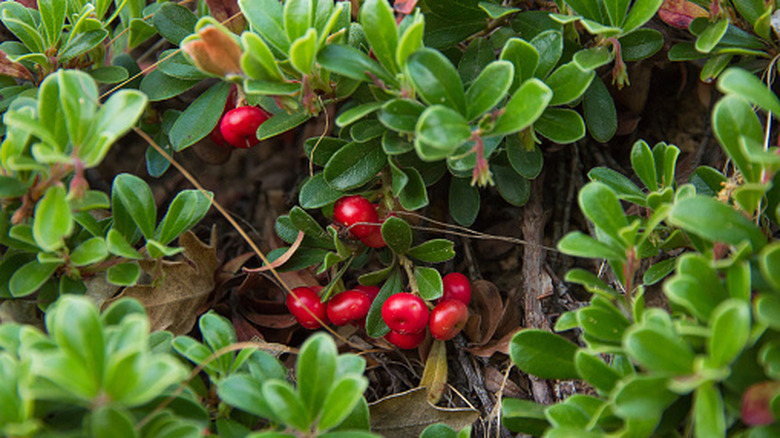The Popular Ground Cover You'll Want To Plant To Add Lasting Color To Your Yard
With the arrival of warmer weather each spring, who can resist the thrill of those little pops of color as trees, bushes, and different types of flowering plants bounce back to life in their vibrant, multicolor glory. Everywhere you turn, nature is showing off with a razzle-dazzle display of budding, blooming, and blossoming. If you're looking for a way to add some pigment to your yard, one popular ground cover makes a multi-season show of its colorful splendor.
Bearberry (Arctostaphylos uva-ursi), also widely known as kinnikinnick, can delight in all four seasons. In spring, this perennial evergreen shrub produces delicate white or light pink bell-shaped flowers. Those give way to bright red berries by late summer. In fall and winter, the waxy dark-green leaves of this low-growing shrub take on a reddish-bronze color before returning to their bright, glossy green in early spring. And you don't even need to mow it — ever. It can help prevent weeds and soil erosion, so it could be a good choice for sloped areas of your yard.
You may have already guessed that bears enjoy eating the small berries of this plant. However, they aren't alone. Bearberry is a big hit with pollinating insects, butterflies, hummingbirds, and other migratory birds and makes a perfect addition for people who love wildlife gardening. The berries are technically nontoxic to humans as well, but are rarely gathered and eaten due to their bland flavor and mealy texture. As such, they are better left to the wildlife.
How to grow colorful bearberry
Bearberry grows well in U.S. hardiness zones 2 through 7 and is drought tolerant, performs best in dry or sandy soil. It's hearty enough to grow on exposed rocks, in gravel, and along riverbanks. As a creeping shrub, bearberry grows at a slow to moderate rate and covers the ground with a thick, woody mat as it spreads. When fully established, bearberry generally grows up to 12 inches in height and up to 6 feet in width, so keep that in mind while planting them if you want an effective ground cover.
Once your bearberry is rooted and well-established, you can propagate it to make more plants with small cuttings. To do this, it's best to wait until late summer or early fall. Cut a 2- to 6-inch length of softwood from that season's growth and replant it once it's established a healthy root system. If you prefer to grow from seed, it's recommended that you purchase them commercially from a nursery due to complications with embryo dormancy and hard seed coats.
Now that your garden is festooned in this beautiful, colorful ground cover, don't stop there! If you're looking for even more hues for your yard, you can also attract wildlife with 'Walker's Low' catmint, a ground cover that boasts lavender-blue flowers. Or perhaps, try a pollinator-friendly ground cover that grows beautifully in shady lawns. No matter your climate or conditions, there are many ground cover options that will bring bountiful colors and beneficial creatures to your yard.

